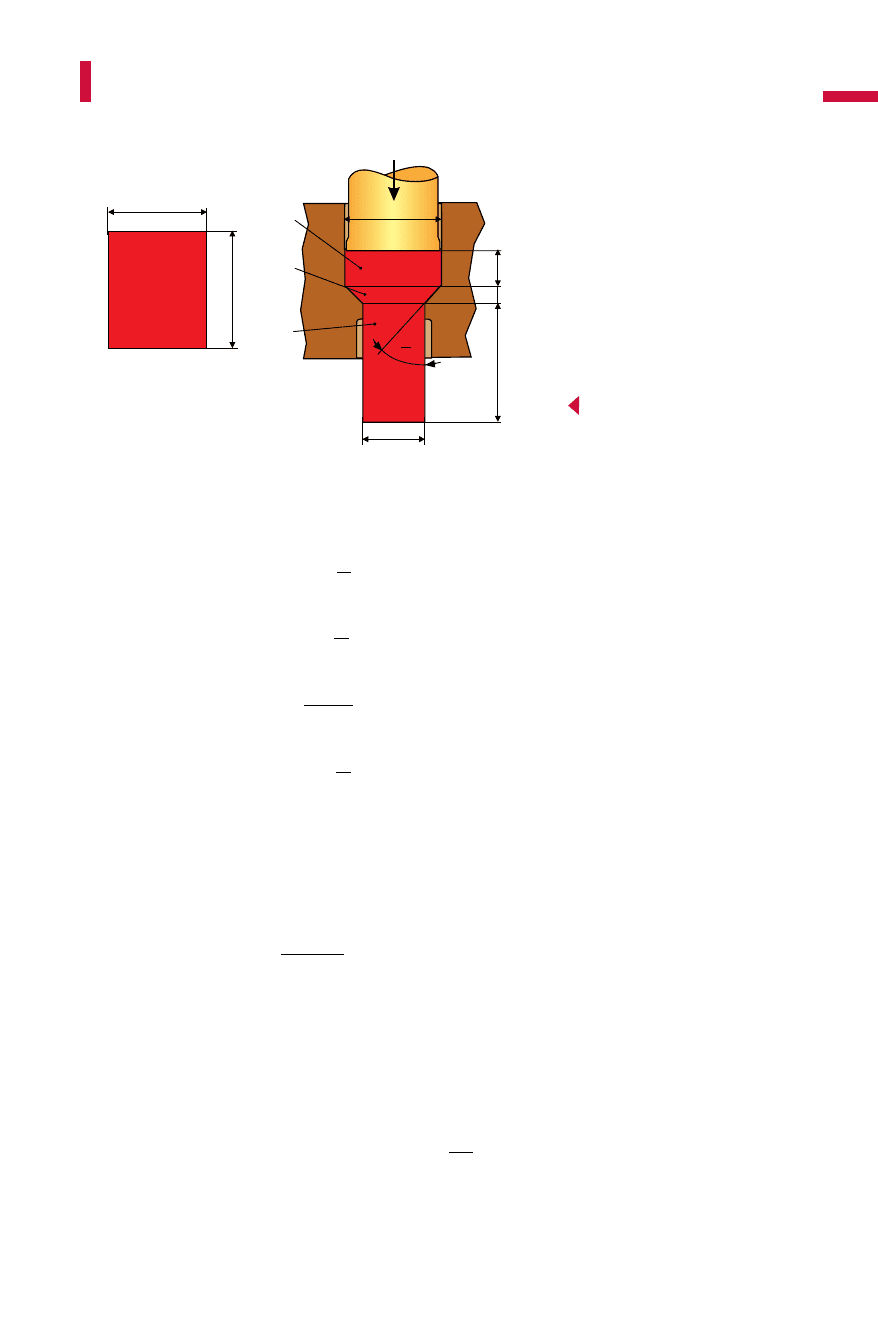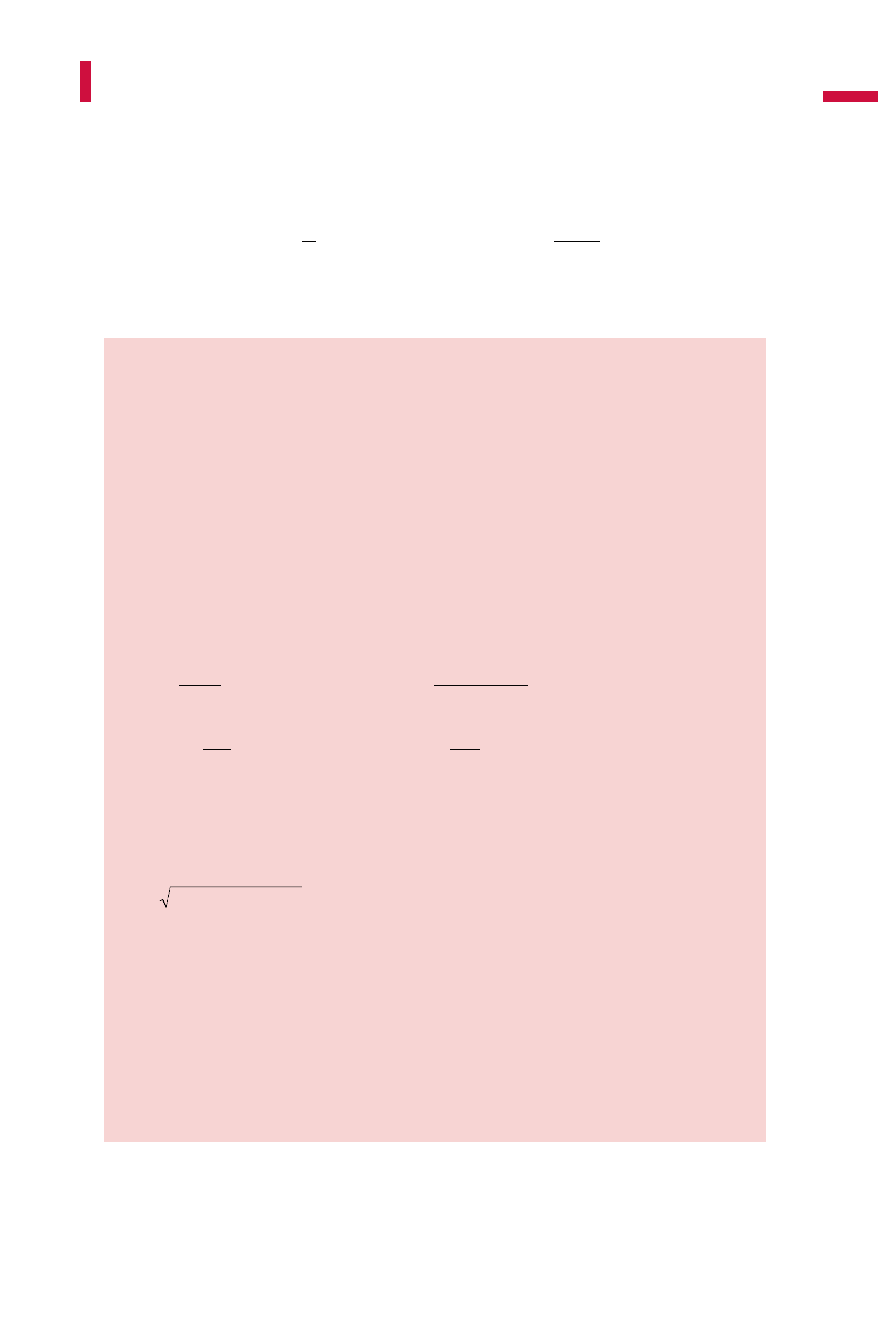Altan T. Metal Forming Handbook
Подождите немного. Документ загружается.


In this calculation, it is possible to use d
2
< d
0
as an approximation; the
height of the truncated cone h
1
’ and the forming stroke h are deter-
mined by means of:
The amount of deformation (strains) can be determined from the
degree of true strain w and the specific cross section change «
A
. The lat-
ter can be obtained quickly from the relevant squares of the diameters
instead of using the surfaces:
471
Force and work requirement
Vd h mm
Vd h mm
V
h
dddd mm
Vd h mm
00
2
0
3
11
2
1
3
1
1
2
2
1
2
21
3
22
2
2
3
4
4
12
4
=⋅⋅
[]
=⋅⋅
[]
=
⋅
⋅++⋅
()
[]
=⋅⋅
[]
'
’
π
π
π
π
d
0
d
2
d
1
F
h
0
V
2
V
1
’
h
1
’
h
2
h
1
V
1
α
2
Fig. 6.5.1
Schematic representation
of forward rod extrusion
h
dd
hh h mm
1
21
02
2
'
–
cot –==
[]
α
ϕ=
ln
d
d
2
2
1
2
Metal Forming Handbook / Schuler (c) Springer-Verlag Berlin Heidelberg 1998

The ratio between billet height h
0
and billet diameter d
0
and the die
opening angle are taken into account with the correction coefficients
k
h
and k
2
a
[–] when estimating the specific punch pressure and thus
also when calculating the forming force.
The flow stress at the start of the forming process k
f0
[N/mm
2
] and
towards the end of the forming process k
f1
can be derived from the
sheets of VDI Guideline 3200 for the material used in each case. Both
values are used to estimate the specific and ideal forming work w
id
:
As the actual forming force deviates from the theoretically ideal form-
ing force, it is corrected by using the effiency factor h
F
[–].
The average forming pressure p
St
[N/mm
2
] and the forming force F
U
[kN] are thus estimated by using:
The forming work W is the product of forming force and forming stroke
h
472
Solid forming (Forging)
ε
ε
=⋅
=⋅
–
%
–
%
AA
A
dd
d
A
A
01
0
2
2
1
2
2
2
100
100
k
h
d
k
h
=⋅+ = ⋅
()
+02 08
1
200
207
0
0
2
.. .
α
α
w
kk
Nmm
mm
id
fo fl
→≈
+
⋅
2
3
ϕ
η
ε
F
A
=⋅
()
0 703125
100
.
%
p
w
kk
N
mm
Fpd kN
St
id
h
USt
=⋅⋅
=⋅⋅⋅
[]
η
π
α2
2
2
23
4
10
–
W F h J resp Nm
U
=⋅
[]
.
Metal Forming Handbook / Schuler (c) Springer-Verlag Berlin Heidelberg 1998

For die design, the pressure on the container wall p
i
[N/mm
2
] is deter-
mined:
Example:
The sample calculation provided here is based on the workpiece material 1.0303
(QST 32-3). The starting values are specified on the left, the characteristic values
subsequent to the pressing operation on the right.
d
0
= 75 mm d
1
= 45 mm a = 45°
h
0
= 110 mm h
2
= 65 mm
d
2
= 75.3 mm
=> h = 45 mm
The resulting deformation or ideal effective strain is
w = 1.03, which corre-
sponds to a relative cross section change of
«
A
< 64 %, and the correction coef-
ficients are k
h
< 1.09 and k
2
a
< 1.15:
If the amount of deformation is 1.03, the resulting value for k
f1
is approx.
740 N/mm
2
, (k
f0
250 N/mm
2
), meaning that the specific forming work is
approx. 471 Nmm/mm
3
. With an efficiency of
the specific die loads, force and work result in:
473
Force and work requirement
ppkk
N
mm
iStff
=++
()
1
2
01
2
ϕε
α
=
==
(
)
⋅=
=⋅
+≈ = ⋅⋅+≈
ln
.
.
.–
.
%%
... ..
75 3
45
103
75 3 45
75 3
100 64
02
110
75
08 109
1
200
245 07 115
2
2
22
2
2
kk
h
η
F
=⋅=0 703125 64 100 0 67./.
pNmm
FkN
esp
Nmm
St
U
i
=⋅⋅≈
[]
=⋅ ⋅⋅≈
[]
=≈
[]
=++
(
)
≈
[]
⋅
510 0 67 1 09 1 15 957
957 75 3 4 10 4 261
4 261 0 045 192
2 957 250 740 974
2
23
2
/. . . /
./ ,
,.
//
–
π
W kJ r . kNm
p1
Metal Forming Handbook / Schuler (c) Springer-Verlag Berlin Heidelberg 1998

6.5.2Forward tube extrusion
Forward tube extrusion involves the production of a tubular part with a
reduced wall thickness starting (cf. Fig. 6.1.1)from a cup or cylinder.
The die opening, which determines the shape of the produced part, is
formed by the press container and the punch. If the mandrel is perma-
nently mounted in the punch, it is called a moving mandrel: As a result
of material flow, additional frictional forces occur which can lead to
critical levels of tensile stress in the mandrel. This can be avoided by
using a moving mandrel, that is moved, within certain limits, by the
deforming material. Friction-related tensile stresses occur during for-
ward extrusion with the moving mandrel and during stripping of the
workpiece in both forward tube extrusion methods. Therefore, geomet-
rical conditions must be set such that mandrel load does not exceed
1,800 N/mm
2
. This is generally the case when the ratio of height to
diameter in the starting material h
0
/d
0
does not exceed 10 to 15. The
achievable levels of deformation depend on the material and corre-
spond to those achievable in forward rod extrusion. Thus, comparable
(shoulder) geometries can also be formed (Table 6.5.1).
6.5.3Backward cup extrusion and centering
A (thin-walled) tubular part is produced from a solid billet. The die
opening which determines the shape of the part is formed by the
punch and container, or the die (cf. Fig. 6.1.1).In the backward cup
extrusion of steel, a certain limiting ratio of penetration depth to punch
diameter h
2
/d
1
= 3 to 3.5 cannot be exceeded. Depending on the mate-
rial, the maximum achievable degree of true strain is w= 0.9 to 1.6
(«
A
= 60 to 80%). However, economical tool life is only achieved with
somewhat lower levels of true strain (Table 6.5.1).
Due to a maximum admissible punch stress of p
St max
#2,300 N/mm
2
when processing steel, a minimum level of true strain of at least w= 0.16
to 0.43 («
A
= 15 to 35%) must be ensured, i.e. it is not possible to back-
ward extrude a cup with any optional internal diameter relative to the
outside diameter. It may be possible to produce small bores with addi-
tional secondary geometries (e.g. a protrusion for extrusion piercing),
provided these relieve the material flow into the cup wall.
474
Solid forming (Forging)
Metal Forming Handbook / Schuler (c) Springer-Verlag Berlin Heidelberg 1998

The minimum achievable wall thicknesses for steel are around 1 mm,
for aluminium around 0.1mm. Extremely thin walls can be produced
by a subsequent ironing process following backward cup extrusion. For
steel, the minimum cup bottom thickness is 1 to 2 mm, for NF metals
0.1 to 0.3 mm. The bottom thickness should always be greater than the
wall thickness (underfilling). In the case of thick-walled cups which are
additionally expected to satisfy high concentricity requirements, it is
advisable to carry out a centering operation prior to cup extrusion.
Centering is a process very similar to backward cup extrusion, although
with only a small deformation stroke. Centering is generally performed
using guided punches.
6.5.4Reducing (open die forward extrusion)
The principle of reducing is similar to that used for forward rod extru-
sion as far as the die design is concerned (cf.Fig.6.1.2). However, in
contrast to forward rod extrusion, the billet material is not pressed
against the container wall. Thus, only a limited degree of deformation
is possible without buckling. During the forming process, the material
must neither be deformed (upset) in the container nor buckle. In the
case of starting billets with h
0
/d
0
> 10, reductions in cross section can
only be achieved using this process. Larger amounts of deformation
require several successive reducing operations. The achievable level of
deformation depends on the material, the preliminary state of strain
hardening and the die opening angle. An overall level of deformation
(calculated from the first to the n
th
reducing operation) of 50 % should
not be exceeded due to the formation of central bursts (chevrons).
Reducing or open die forward rod extrusion is a process which is not
used in practical warm forming operations, as the achievable degree of
deformation is too low due to significantly reduced flow stress in warm
forming.
With a die opening angle of approx. 20°, it is possible to achieve a
maximum level of deformation of w= 0.3. If the material used has
already been strain hardened, for example as a result of a previous
reducing operation, a somewhat higher degree of deformation is possi-
ble. However, with an increasing die opening angle, the achievable lev-
el of deformation drops substantially.
475
Force and work requirement
Metal Forming Handbook / Schuler (c) Springer-Verlag Berlin Heidelberg 1998

Die angles range between 10 and 45°and generate tapers with shoul-
ders between a= 5 and 22.5°on the pressed part (cf.Fig.6.1.2).The
punch load is of minor importance, and depends on the billet material.
It should not upset the billet plastically, and cause buckling stresses in
slender billets. Neither of these stress values should be exceeded. The
process is highly sensitive to fluctuations in the strength of the starting
materials and to the quality of lubrication, i.e. phosphating and soaping.
6.5.5Ironing
Ironing is a process whereby a tubular part with a bottom (e.g. backward
extruded or drawn cup) is drawn to reduce the wall thickness (cf.
Fig.6.1.2).This is a process in which the force is introduced mainly
through the bottom of the workpiece and partially by the mandrel fric-
tion force. As a result, in addition to compressive stress at the die shoulder
inlet, tensile stress also occurs after exit from the die in the wall of the
workpiece (drawing process). This is in direct contrast to reducing, in
which the force and thus also the compressive stress occurs in the work-
piece cross section before the die shoulder inlet (press through process).
The part shape is generated by the drawing mandrel and the ironing (die)
ring. It is also possible to arrange several ironing rings one after the other.
The maximum degree of true strain achievable when ironing steel is
around w= 0.5 («
A
= 40%) depending on the material characteristics.
For difficult to form materials this value drops to w= 0.35 («
A
= 30%).
Die opening angles may range up to around 45°, which results in tapers
up to 22.5°in the finished part (cf. Fig. 6.1.2)Customary die opening
angles for ironing range between 5 and 36°. A minimum punch force is
achieved at an ironing angle of around 12°, when the probability of
wall fracture is minimum. Ironing is a process in which an extremely
good surface quality and excellent tolerances are achieved, and it is,
therefore, used frequently as a sizing operation.
6.5.6Upsetting
Upsetting is defined as “free forming”, a process in which the part
height is reduced, generally between flat parallel die surfaces (upsetting
476
Solid forming (Forging)
Metal Forming Handbook / Schuler (c) Springer-Verlag Berlin Heidelberg 1998

dies) (cf. Fig. 6.1.2).If upsetting is carried out in a closed die without
flash formation, for example in order to press cylindrical or lens-shaped
pre-forms, this is referred to as sizing.
(Free) upsetting (cf. Fig. 2.2.1) is characterized by three process limits:
Depending on the material, the maximum true strain of w= 1.6 can be
achieved. The upsetting ratio h
0
/d
0
(height to diameter of the starting
workpiece) may not exceed 2.3 for single pressing, 4.5 for dual pressing
and 8.0 for triple pressing, as otherwise buckling may occur and the
fiber flow is interrupted (cf. Fig. 6.2.1).The maximum die pressure is
2,300 N/mm
2
.
In contrast to upsetting in which the exterior contour and dimen-
sion are free formed, in sizing the workpiece is fully enclosed (trapped
die). The same process limiting values exist as for free upsetting.
However, the same magnitude of the upsetting punch load is reached at
lower levels of deformation, as the material leans against the die wall.
6.5.7Lateral extrusion
Lateral extrusion generates shapes with flanges, collars or other geo-
metric features (teeth, protrusions), whereby the die opening which
gives the workpiece its shape remains unchanged during the entire
forming process (cf. Fig. 6.1.1). This is achieved by closing the dies with
a high force before the slide reaches the bottom dead center. After the
dies are closed, the material is pressed into the impression by the pene-
trating punch. It is possible to produce for example flanges with a diam-
eter ratio D
1
/d
0
#2.5 in a single forming operation. The ratio between
flange thickness and starting s/d
0
should not exceed 1.4 because the
material may separate at the neutral surface.
The required forces are substantially lower than for upsetting, in par-
ticular when pressing secondary geometric features. To date, the actual
force requirement has been estimated only through experimental tests.
Because of the state of compressive stress, acting on all sides, local
levels of true strain of up to w= 5 have been achieved using this non-
stationary process.
477
Force and work requirement
Metal Forming Handbook / Schuler (c) Springer-Verlag Berlin Heidelberg 1998

6Solid forming (Forging)
6.6Part transfer
Cold and warm forming are mass production processes whose high out-
put levels and economy are achieved in particular by automation.
Automation in this context includes all devices which, in addition to
loading the wire coil or filling the containers with sheared billets, permit
the transfer of the billet, the preformed part between forming, and where
applicable any scrap (piercing, trimming operations) within the press.
Installations that use wire coil have the advantage that once the wire
end has been fed in, the billet material always assumes a defined posi-
tion during the straightening (cf. Sect. 4.8.3), drawing and shearing (cf.
Sect. 6.3). The material is transported within the press by means of a
mechanical transfer device, and the parts leave the press following the
last forming station by sliding down through a chute. In installations
that use sheared billets, the billets must be fed in, oriented, possibly
weighed and conveyed to the pick-up point of the transfer device. The
main focus of investigation part handling is the transportation of work-
pieces from one station to the next within the press. The objective is to
utilize kinematic factors and die layout so to:
–guarantee absolutely reliable part transfer – this entails prevent-
ing the part from assuming an undefined, i.e. free position at any
time –,
–ensure that no collision is possible either between the die elements or
between die elements and grippers during idle stroking of the press
(e.g. on start-up or when running the press empty), and
–minimize contact times, in particular in the case of warm forming.
Metal Forming Handbook / Schuler (c) Springer-Verlag Berlin Heidelberg 1998

There is a broad range of possible solutions for part transfer, includ-
ing transport devices in the broader sense, such as tilting mechanisms
for billet containers, steep conveyors (pusher or chain conveyors),
vibrating conveyors, separating devices and scales. Therefore, these will
not be dealt with here. This chapter will concentrate instead on the
loading station and the transfer study for a mechanical cold forming
press with 2D transfer (cf. Sect. 4.4.6).
6.6.1Loading station
The wide diversity of parts that must be fed into a forming press calls
for a number of different loading station concepts. Where cylindrical
billets with a length/diameter (L/D) ratio greater than 0.8 are being
processed, they are loaded from above into the feeding station by
means of a feed channel (Fig.6.6.1,top). The bottom-most parts are
held in a holder, generally cylindrical in shape, that is provided with
recesses on the side to allow for the closing movement of the gripper.
Following the removal of the first part, the weight of the column caus-
es it to drop onto the base plate at the level of the transport plane.
Where billets with different dimensions are fed, if necessary the feed
channel and the exchangeable parts or the complete feed unit can be
exchanged with the aid of quick-acting clamps. The grippers are
equipped for cylindrical parts with prismatic active gripper elements
whose height should be approx. 50% of the billet length to ensure a
reliable gripping action.
If the L/D ratio is below around 0.8 to 1, or if formed parts with rela-
tively flat geometry are being processed (Fig.6.6.1,bottom),then the
parts are conveyed into the loading station side by side in specially
designed feed channels. The parts are positioned initially below the
transport plane, and are raised by a pusher to transport level in synchro-
nization with the press cycle. After the pusher returns to its starting posi-
tion, the next part slips into the loading station to be raised to the trans-
port plane. The starting height and feed angle of the feed channels are
configured in such a way that the billets continue to slide under their
own weight. In the case of formed parts, the grippers are designed for
shaped fit if a prismatic gripper exhibits an unfavorable L/D ratio and
there is a danger that billets could rotate while being held by the gripper.
479
Part transfer
Metal Forming Handbook / Schuler (c) Springer-Verlag Berlin Heidelberg 1998

480
Solid forming (Forging)
Fig. 6.6.1 Loading station concepts for cylindrical
(top),
disc-shaped or flat shaped parts
(bottom)
Metal Forming Handbook / Schuler (c) Springer-Verlag Berlin Heidelberg 1998
